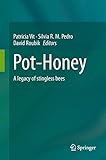Pot-honey: a legacy of stingless bees / Patricia Vit, Silvia R. M. Pedro, David W. Roubik, editors
Vit, Patricia [editora] | Pedro, Silvia R. M [editora] | Roubik, David Ward [editor] .
.
Tipo de material:  Libro
impreso(a)
Editor: New York, New York, United States: Springer Science+Business Media, 2013Descripción: xxviii, 654 páginas : fotografías, ilustraciones, mapas, retratos ; 24 centímetros.ISBN: 1461449596; 9781461449591.Tema(s): Abejas sin aguijón
Libro
impreso(a)
Editor: New York, New York, United States: Springer Science+Business Media, 2013Descripción: xxviii, 654 páginas : fotografías, ilustraciones, mapas, retratos ; 24 centímetros.ISBN: 1461449596; 9781461449591.Tema(s): Abejas sin aguijón| Tipo de ítem | Biblioteca actual | Colección | Signatura | Estado | Fecha de vencimiento | Código de barras |
|---|---|---|---|---|---|---|
| Libros |
Biblioteca San Cristóbal
Texto en la configuración de la biblioteca San Cristóbal |
Acervo General | 638.1 P67 | Prestado | 01/04/2023 | ECO010017640 |
Incluye bibliografía e índice
Stingless bees of Guatemala Carmen Lucía Yurrita Obiols and Mabel Vásquez páginas 99-111 Stingless bee food location communication: from the flowers to the honey pots Daniel Sánchez and Rémy Vandame páginas 187-199 Medicinal uses of melipona beecheii honey, by the ancient maya Genoveva R. Ocampo Rosales páginas 229-240 The pot-honey of guatemalan bees María José Dardón, Carlos Maldonado-Aguilera, and Eunice Enríquez páginas 395-408
Part I Origin, Biodiversity and Behavior of the Stingless Bees (Meliponini.. 1 The Meliponini.. 2 Historical Biogeography of the Meliponini (Hymenoptera, Apidae, Apinae of the Neotropical Region.. 3 Australian Stingless Bees.. 4 Stingless Bees from Venezuela.. 5 Stingless Bees (Hymenoptera: Apoidea: Meliponini of French Guiana.. 6 Stingless Bees of Guatemala.. 7 Stingless Bees of Costa Rica.. 8 Stingless Bees in Argentina.. 9 Mexican Stingless Bees (Hymenoptera: Apidae: Diversity, Distribution, and Indigenous Knowledge.. 10 The Role of Useful Microorganisms to Stingless Bees and Stingless Beekeeping.. 11 Microorganisms Associated with Stingless Bees.. 12 Stingless Bee Food Location Communication: From the Flowers to the Honey Pots.. 13 On the Diversity of Foraging-Related Traits in Stingless Bees.. Part II Stingless Bees in Culture, Traditions and Environment.. 14 Stingless Bees: A Historical Perspective.. 15 Medicinal Uses of Melipona beecheii Honey, by the Ancient Maya.. 16 Staden's First Report in 1557 on the Collection of Stingless Bee Honey by Indians in Brazil.. 17 Melipona Bees in the Scientific World: Western Cultural Views.. 18 Taxonomy as a Tool for Conservation of African Stingless Bees and Their Honey.. 19 Effects of Human Disturbance and Habitat Fragmentation on Stingless Bees.. Part III What Plants Are Used by the Stingless Bees?.. 20 Palynology Serving the Stingless Bees.. 21 How to Be a Bee-Botanist Using Pollen Spectra.. 22 Important Bee Plants for African and Other Stingless Bees.. 23 Botanical Origin of Pot-Honey from Tetragonisca angustula Latreille in Colombia.. Part IV Sensory Attributes and Composition of Pot-Honey.. 24 Sensory Evaluation of Stingless Bee Pot-Honey.. 25 Melipona favosa Pot-Honey from Venezuela.. 26 Tetragonisca angustula Pot-Honey Compared to Apis mellifera Honey from Brazil
27 Honey of Colombian Stingless Bees: Nutritional Characteristics and Physicochemical Quality Indicators.. 28 The Pot-Honey of Guatemalan Bees.. 29 Pot-Honey of Six Meliponines from Amboró National Park, Bolivia.. 30 An Electronic Nose and Physicochemical Analysis to Differentiate Colombian Stingless Bee Pot-Honey.. 31 Nuclear Magnetic Resonance as a Method to Predict the Geographical and Entomological Origin of Pot-Honey.. 32 Nonaromatic Organic Acids of Honeys.. Part V Biological Properties.. 33 Flavonoids in Stingless-Bee and Honey-Bee Honeys.. 34 Antioxidant Activity of Pot-Honey.. 35 Use of Honey in Cancer Prevention and Therapy.. 36 Bioactivity of Honey and Propolis of Tetragonula laeviceps in Thailand.. 37 Costa Rican Pot-Honey: Its Medicinal Use and Antibacterial Effect.. 38 Immunological Properties of Bee Products.. 39 Chemical Properties of Propolis Collected by Stingless Bees .. Part VI Marketing and Standards of Pot-Honey.. 40 Production and Marketing of Pot-Honey.. Appendix A Taxonomic Index of Bees.. Appendix B List of Bee Taxa.. Appendix C Common Names of Stingless Bees.. Appendix D Taxonomic Index of Plant Families.. Appendix E List of Plant Taxa Used by Bees.. Appendix F Common Names of Plants Used for Nesting by Stingless Bees.. Appendix G Common Names of Medicinal Plants Used with Honey by Mayas.. Appendix H Microorganisms Associated to Stingless Bees or Used to Test Antimicrobial Activity.. Appendix I Summary of Meliponine and Apis Honey Composition.. Appendix J Information of Collected Stingless Bees.. Index
The meliponines, stingless honey-making bees, encircle the tropical world and penetrate every forest there. This book brings together and synthesizes, on a global scale and for the first time, information on these bees as honey producers and natural alchemists. Their ability to store their food in flexible cerumen 'pots' made from wax and resin enables them to produce honey for which the world has no other source. These little known and often rare denizens of remote reaches of the globe have found a way to produce honey and survive in the permanently wet and unforgiving rain forests, since before the continents of Africa and South America split apart 100 million years ago. In Australia, we find them equipped to survive in cold deserts, and in the Amazon some feed within the nests of other social bees, utilize flesh of dead animals, or even live among scale bugs that give them food and building material. Some are obligate parasites, stealing the brood food from inside nests of other meliponines. Pot-honey is a minor honey in the market but a major honey in the forest, produced by many hundreds of flowering plants and demanding integrated conservation. Complementing the unifloral honeys of Apis mellifera, many more pot-honeys are yet to be appreciated by the public. The analytical corpus developed to study and standardize honey produced in combs is also valid for pot-honey. Honey ferments inside the nests of Meliponini, and the process continues after harvest. According to A. mellifera standards it is spoiled, yet a more medicinal product results and may remodel our concept of honey. As shown here, the meliponines, support a legacy of bees interacting with human culture, traditions, art, science and philosophy. eng
